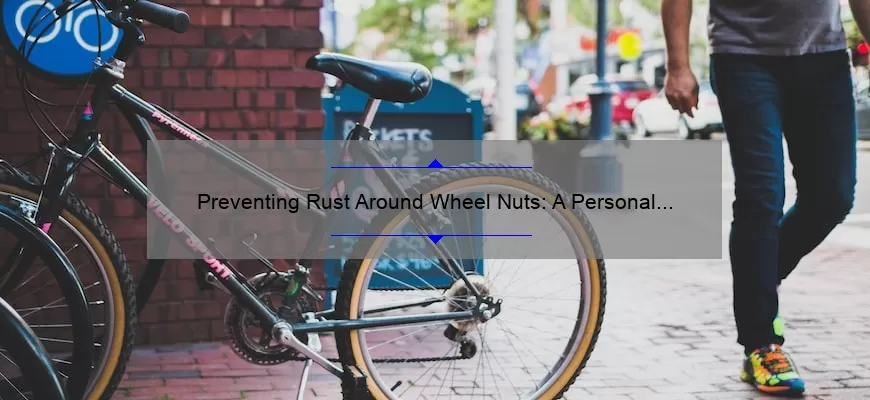- Short answer: Rust around wheel nuts may mean
- How to Identify Rust Around Wheel Nuts May Mean: A Step-by-Step Guide
- FAQ About Rust Around Wheel Nuts and What It Could Mean for Your Vehicle
- Top 5 Facts You Need to Know About Rust Around Wheel Nuts May Mean
- The Dangers of Ignoring Rust Around Your Vehicle’s Wheel Nuts
- How to Prevent and Treat Rust Formation around the Wheel Nuts of Your Car
- Signs That Indicate the Presence of Rust Around Car Wheel Nut Areas
- Table with useful data:
- Information from an expert
- Historical fact:
Short answer: Rust around wheel nuts may mean
There could be several reasons for rust around the wheel nuts, but it is mainly an indication of corrosion. Corrosion can weaken the metal and compromise safety, leading to potential damage to the vehicle’s wheels or even a nasty accident on-road. Tightening lug nuts at their proper torque settings during installation can prevent rust formation due to avoiding any gaps that might invite moisture or air penetration under the nut surface.
How to Identify Rust Around Wheel Nuts May Mean: A Step-by-Step Guide
Rust is one of the worst enemies that automobiles face. It can erode metal parts, weaken the structural integrity of a vehicle and be an eyesore to boot. As a result, identifying rust around wheel nuts should prompt you into action as soon as possible.
But how exactly do you know if there’s rust? And what steps should you take once it’s been confirmed? We’ll break down everything you need to know in this step-by-step guide on identifying tire rust.
Step 1: Inspect Your Wheels
Before we even get started with the technical bit, let’s start by visually inspecting your wheels for any signs of discoloration or damage. With a visual inspection, it will be easy to identify any rust development around the edges of wheel hubs, spokes or rims.
Make sure that every part on each individual wheel is examined thoroughly – this includes checking out all five lug nuts; look at both sides where they bolt onto the car (the outer side and inner side).
Step 2: Take A Closer Look At The Wheel Nuts
Once you’ve identified that there could potentially be some corrosion-related issues happening on your automobile’s wheels, pay closer attention specifically to your lug nuts (that keep your tire attached to your car).
More often than not, rust begins near these areas since dirt particles and moisture can accumulate easily causing oxidation which accelerates the development process. Check each nut individually so that nothing is missed during an overviewal scan.
Step 3: Tap Test Each Nut Individually
Now comes testing time- if upon close examination you suspect rusty regions —use sharp objects like screwsdrivers or similar tools—tap gently against them capturing exact sound response data gathered from this method!
Tapping them carefully with such items would help determine whether they felt sturdy enough –or were deteriorated because sufficient movement occurred–so correct estimations might lead towards providing better solutions when decisions arise about what action(s) taken for rust prevention!)
Step 4: Evaluate The Severity Of Rust
In the end, it’s always wise to understand how severe a problem you’re tackling. A few spots here and there isn’t too worrisome, but widespread corrosion across multiple lugs might have eaten significantly into that bolt’s strength.
It goes without saying that if one of those wheel nuts breaks off when driving could be perilous if this is not fixed immediately! Therefore take swift actions as soon as possible-while early detection plays an important role in saving troubles later on!
Conclusion:
As we’ve covered above; spot-checking your wheels by sight can already give indication they might need closer inspection. Once you’ve done so, evaluate each individual lugnut before deciding what necessary steps required now (full replacement or tightening issues).
Understanding rust magnitudes present around these wheels will help avoid dangerous situations whilst ensuring continual & smooth movement going forward. If unsure about completing the job solo-consider visiting nearby expert mechanics who would gladly do so themselves efficiently with professional tips to maintain longevity out their workmanship!
FAQ About Rust Around Wheel Nuts and What It Could Mean for Your Vehicle
Rust around wheel nuts can be a common issue that many vehicle owners face. This rust is not only unsightly but it can also cause serious problems for your vehicle’s wheels and brakes in the long run.
In this blog post, we will cover some frequently asked questions about rust around wheel nuts, and what it could mean for your car.
1) What are wheel nuts?
Wheel nuts are small metal parts that screw onto the threading on the studs of your car’s wheels to keep them attached to the hub assembly.
2) Why does rust form around wheel nuts?
Rust forms when oxygen comes into contact with iron or steel. When moisture gets through any cracks in the paint or protective coating on the surface of the nut, oxidation occurs which leads to corrosion resulting in rust formation.
3) Is rust around wheel nuts dangerous?
While you might think that a little bit of rust isn’t particularly harmful, over time, this can lead to more severe damage if left unchecked. Rust results in swelling – even small amounts forming around important bolts like those holding your wheel lugnuts tight because water/moisture remains trapped beneath then begins reacting with unprotected metal surfaces within reach
4) Can I prevent my car’s wheels from developing rusted areas?
There are things you can do such as proper cleaning/washing immediately after driving on salty winter roads or simply rinsing down exposed bolt heads once weekly during extreme weather conditions.
5) If there is significant amount of rusty substance surrounding my car’s wheels should I replace them?
Almost always worth consulting with an automotive body shop professional experienced repairing driveline assemblies since they would have access specialty materials/tools designed specifically rendering different levels/types corrosion damage effectively thereby preventing awkward situations while renewing worn out components ensuring everything works smoothly together again so further problems don’t emerge soon afterward.
6) Does insurance cover repairs due to driver-caused issues like untreated metal corroding overtime leading up towards costly repairs?
Generally speaking, car insurance policies don’t cover rust repair unless the reason it formed naturally and gradually came up through normal wear and tear rather than being caused directly by reckless driving, exposure to flooding or related damages.
7) How do I get rid of wheel nut rust?
There are varying methods of removing corrosion from around bolts as well getting rid off surface-level rust. Typically requires heavy duty mechanical tools that can physically grind away any corroded material without damaging other parts nearby. Also a solution of baking soda mixed with vinegar helps dissolve accumulated salt deposits which accelerates oxidation process for better structural integrity over time because no stale moisture remains clogging pores/nooks crannies hidden beneath surfaces to eat whatever unprotected metal is available.
In conclusion, if you start noticing signs of rust forming around your car’s wheels then it’s essential to take necessary actions before it turns into bigger problems such as worn brakes, severe steering system issues leading collision risk on the roadways.Safe practices like keeping exposed areas clean after usage periods/especially in extreme weather conditions significantly reduce risk observed recurring corrosion only becomes more rampant over the course aging/mileage traveling depending upon where/how frequently driven. Hopefully these FAQs have helped clear out confusion surrounding rusty bolt fixes so feel free contact seasoned automotive experts at specialist shops who may be able provide counsel bespoke solutions fitting different owner needs!
Top 5 Facts You Need to Know About Rust Around Wheel Nuts May Mean
Rust around the wheel nuts of your vehicle can be a sign of potential issues that need to be addressed as soon as possible. While it may not always mean imminent danger, ignoring rust could lead to bigger problems down the road – quite literally! Here are the top five facts you need to know about rust around wheel nuts:
1) Rust is an indication of moisture exposure: If there’s one thing we know for sure, it’s that moisture and metal don’t mix well. The presence of rust around your wheel nuts means that water has likely seeped into the area, indicating potential leakage from somewhere in the brake system.
2) It undermines structural integrity: When rust starts spreading on parts such as lug bolts or studs, this weakens their structure and poses a risk to your vehicle’s safety. This could result in wheels coming off while driving if left unattended for too long – now that’s a scary thought!
3) It affects alignment and tire wear: Damaged wheel components due to corrosion will impact how tightly tires can fit onto them. As a result, misalignment occurs gradually over time which leads to uneven tread wear plus posing handling challenges thus leading towards bigger problems
4) Minor surface rust is not worrisome: Surface-level rust is usually nothing more than just an eyesore but does not pose any harm if treated immediately by using proper solutions like sandpapering with wire-brush or DIY chemicals
5) Seek professional help at first opportunity : Whenever noticing signs of corrosion anywhere along depending upon severity levels consulting professionals right out should come under keystone things because worsening up conditions would eventually only cause further complications with finances+painstaking efforts.
To prevent these issues from turning into catastrophic ones , visit your mechanic who can identify what caused the problem in the first place and give appropriate maintenance suggestions that keep future damage at bay-any day better preventing troubles reign later than regretting scenarios when they overdrew possibilities!
The Dangers of Ignoring Rust Around Your Vehicle’s Wheel Nuts
Rust around your vehicle’s wheel nuts might seem like just one of those little annoyances that come with owning a car. After all, it doesn’t impact how the car drives, right? Unfortunately, ignoring rust around your wheel nuts can actually be incredibly dangerous- and here is why.
Firstly, let’s take a closer look at what rust actually is: rust isn’t just some unsightly discoloration on metal – it’s an actual chemical reaction between iron and oxygen. This process weakens the integrity of metal objects by causing them to corrode from within. While you may not see any physical signs of weakness or cracking initially, over time as more and more layers of rust build up on top of each other they will eventually start to deteriorate completely.
Now let’s apply this concept specifically to car wheels; we know that most vehicles are designed based around uncompromised safety standards so the structural engineering for each component must meet certain rigorous criteria before being installed into your vehicle. Your car’s wheels are no exception. Simultaneously maintaining correct alignment and inflation levels throughout their lifetimes ensures optimal driving dynamics while also absorbing rough terrain conditions-a critical requirement for occupant safety.To provide maximum strength against wear & tear due to frictional forces arising form speed or persistence force during sharp turns alternate acceleration patterns,the manufacturer uses high grade metals such as aluminum alloys or steel in conjunction with standardized anti-corrosion coatings– unfortunately over time these pre-treatment coating sustainable duration weakens handing off potential risk assessment which poses further threat to safety codes despite incorporating multiples technology mitigation.
A rusty wheel increases this fragmentation likelihood tenfold!It does NOT matter whether its surface corrosion (well visible) or accumulated corrosion-perhaps out-of-sight-underneath-thereby waiting silently until something fails.An average drivers sees rim lightly dampened with brown patches on areas surrounding lugs & never cares about investing money in fixing simple issue.it becomes so serious that once the actual bolts holding rear or front wheel tire to car hub is compromised, the consequences couldn’t be more grave.
At every moving point screws connect our vehicles wheels to suspension mechanism:even at 20 miles per hour ,stripped thread can turn a regular day drive on it’s head;let alone quicker velocities notably seen in most North American expressways eg.”I-5″.The result one now faces from underestimating corrosion due mounting pressure may lead & culminate into serious life-altering incidents-the type you see on news channel after alike accident occurs.The issue for drivers though isn’t just preventing these worst-case scenarios, but about avoiding even milder forms of damage.Increasing kinetic energy along with friction based contact points generates heat and degrades thermal capacity among key areas which once would have provided adequate strength thus creating opening window for overall part failure.Basically the metal has changed its physical properties .It’s now highly liable to crack under any reasonable load.
In summary:rust around your vehicle’s wheel nuts is not simply an eyesore – it’s actually an incredibly dangerous problem that shouldn’t be ignored.Remember “precaution is better than cure” as prevention remains cheaper and easier than mitigation.Doing simple maintenance such as scrubbing off rust immediately while getting coatings re-applied by authorised mechanic could save multiple seconds or worse still ,save lives!
How to Prevent and Treat Rust Formation around the Wheel Nuts of Your Car
As a car owner, you know how essential proper maintenance is to keep your vehicle running smoothly. Among the many things that require attention, one critical aspect of upkeep is preventing or treating rust formation around the wheel nuts. Not only do rusty wheel nuts pose an unsightly appearance for your vehicle, but it can also result in some severe safety hazards if not taken care of promptly.
Fortunately, preventing and treating rust formation around the wheels’ lug nuts isn’t difficult at all with these easy tips below:
1. Regularly Clean and Dry (Especially After Rainy Days)
One way to prevent rust on your car’s wheels is by washing them regularly and ensuring they’re always dry after cleaning. This process will help remove any dirt or debris buildup while exposing any surface corrosion early enough so that you can take swift action.
Moreover, moisture accumulation from rainy weather allows corrosion and pitting to happen faster; hence drying them off immediately after being exposed to wetness goes a long way towards preventing damage caused by water.
2. Apply Wax Protectant
Applying wax protectants on top of clean and dry wheel surfaces acts as an added layer of protection against all types of elemental hazards posed by rainwater, snow sleet or hailstones during stormy days; this prevents further vehicle deterioration both in terms of its paint coloration as well as structural deterioration due to oxidation.
Consequently waxing alloys regularly helps fight against brake dust build-up alongside grease residues settling within threads surrounding each bolt hole which are known accelerators for iron-based degradation leading up eventually turning orange!
3. Rust Remover Solution
In instances where rust has already set in around the nuts’ edges despite frequent washings or protective coatings such as liquid waxes spray-ons above moisturised metal parts – then using baking soda partnered with gentle abrasive brushes may become necessary since traditional solutions would be detrimental towards making matters worse instead!
Baking soda offers an effective alternative treatment method made from coarse granules – when mixed with water creates a paste that is excellent at eliminating even the most stubborn rust buildup.
Final Thoughts
In conclusion, preventing and treating rust formation around your wheel nuts is essential to maintain your car’s safety and appearance. Ensure you clean and dry them regularly, apply wax protectant for extra protection, or use baking soda solutions for worse predicaments like orange-looking lug nuts! With these tips followed religiously – you’ve given an assurance that wheels won’t suffer from accelerated depreciation but instead maintaining pristine conditions long into their life span without any issues arising whatsoever.
Signs That Indicate the Presence of Rust Around Car Wheel Nut Areas
As a car owner, rust can be one of your worst enemies. It’s not only unsightly but it can also weaken the structural integrity of your vehicle. And when it comes to the wheel nut areas of your car, you need to be extra vigilant since any sign of corrosion can compromise the safety and performance of your wheels.
Here are some signs that indicate the presence of rust around car wheel nut areas:
1) Discoloration: The first sign that there is rust on or near your wheel nuts will manifest itself in discoloration. This could appear as anything from small patches all over to much larger stains covering entire sections or even whole wheels themselves. If you see this type of discoloring around where your lug nuts attach to the hub assembly or axle flange then it’s time for immediate action!
2) Loose Lugnuts: When rust builds up on certain parts such as lugnuts holding up tires after going through tough weather conditions like heavy snowfall and rain storms, they tend to become loose quite quickly which puts driver and passenger at risk while driving down highways with fast-moving traffic.
3) Hardened Wheel Nuts: Due to extended periods without use, metal gradually deteriorates leaving behind hard-to-remove grime in every area imaginable including hardening around threads where lugs connect onto axles resulting stoichometrically tightening issues as well.
4) Squeaking Sound From Tires: A metallic sound whilst steering away indicates progressive oxidation caused by corroding components – often due either too moisture accumulation under disc brakes or rust formation upon “surface covered” elements within the vicinity margins such as rims and hubs etcetera during storage – . As automotive manufacturers generally preach very selectively about spotting these signs early enough; detection might just save someone his/her life if caught early enough — so never leave unchecked regarding sounds emanating from tire wells nor ignore squeaks arising beneath cab interiors during slow rotations @ higher gears particularly on bumpy roads filled with potholes!
5) Uneven Tire Wear on Dry Roads: When rust forms in the area around wheel nuts, it can cause uneven tire wear especially when driving under dry weather and conditions that exacerbate wear-and-tear. If you notice your tires wearing out asymmetrically or see ridges appearing between tread blocks which tilt severely to one direction then inspecting lug bolts would be wise.
In conclusion, keeping an eye out for signs of corrosion by regular inspection will help prevent serious problems from taking root. The longer you allow rust to accumulate near your car’s wheel nut areas; brake rotors assembly flanges bearing play could become permanently damaged resulting either collisions due too steering difficulties if kept unattended at all costs! Don’t neglect these sobering truths learn more about best practices maintenance over time so as never finding yourself negating road safety provisions formulated by adherent industry customsespecially in drive train components subjected towards heavy extremes like off-roading contexts etcetera where each inch counts between life & death scenarios — ultimately making good informed decisions will ensure longevity for you and other drivers within vicinity thereby avoiding unnecessary expenses otherwise incurred along way akin to replacing costly parts if issued too late !
Table with useful data:
| Condition | Possible causes | Recommended actions |
|---|---|---|
| Rust around wheel nuts | Poor maintenance or exposure to moisture | Remove rust and apply anti-corrosion treatment; tighten nuts to manufacturer’s specifications |
| Loose wheel nuts | Improper torque settings or excessive vibration | Retorque nuts to manufacturer’s specifications; check suspension and alignment |
| Noisy brakes | Worn brake pads, warped rotors, or dirty brake components | Replace brake pads and/or rotors; clean and lubricate brake components |
| Poor fuel efficiency | Dirty air filter, low tire pressure, or mechanical issues | Replace air filter; inflate tires to recommended PSI; visit mechanic for diagnosis and repair |
Information from an expert
Rust around wheel nuts is often a sign of corrosion, which can be caused by exposure to water or salt. When this happens, it’s important to address the issue promptly as it could lead to safety concerns while driving. Rusty wheel nuts may become loose over time due to the weakening of the metal and ultimately cause the wheels to detach from the vehicle while in motion. This is why regular inspections and preventive maintenance are essential for ensuring your safety on the road. Remember that whenever you notice rust around your wheel nuts, seek help from a professional mechanic immediately.
Historical fact:
In the early days of automobile manufacturing, rust around wheel nuts was a common problem due to inferior materials and lack of proper maintenance. This issue often resulted in wheels becoming loose or even falling off while driving, leading to serious accidents on the road. Today, modern cars are designed with materials that resist corrosion and advanced safety features to prevent such incidents from occurring.




![Unlocking the Mystery of Black Gorilla Lug Nuts: A Story of Strength and Style [5 Essential Tips for Choosing the Best Lug Nuts]](https://baru-nuts.com/wp-content/uploads/2023/04/21-335x220.jpg)
![Rev Up Your Ride: The Ultimate Guide to Black Chrome Lug Nuts [Solve Your Wheel Woes with Expert Tips and Stats]](https://baru-nuts.com/wp-content/uploads/2023/04/22-335x220.webp)
![Binky Goes Nuts: A Tale of a Mischievous Pet and How to Keep Them Calm [Expert Tips and Stats]](https://baru-nuts.com/wp-content/uploads/2023/04/23-335x220.jpg)

